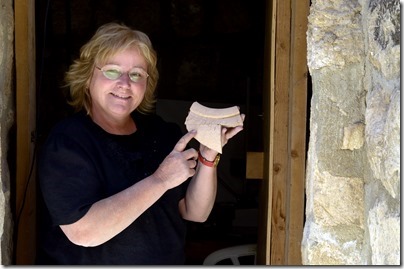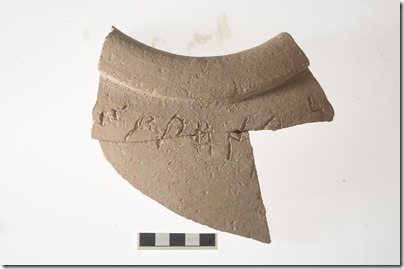Eilat Mazar is claiming to have found the earliest alphabetic inscription ever discovered in Jerusalem.
Readers may recall that she found the earliest written inscription several years ago in a fragmentary cuneiform tablet. She is dating this one to the tenth century BC, but the basis for this date is not given. Mazar has been heavily criticized in the past for dating her discoveries to the time of David in order to attract more publicity.
From the Hebrew University press release:
The inscription is engraved on a large pithos, a neckless ceramic jar found with six others at the Ophel excavation site. According to Dr. Mazar, the inscription, in the Canaanite language, is the only one of its kind discovered in Jerusalem and an important addition to the city’s history.
Dated to the tenth century BCE, the artifact predates by two hundred and fifty years the earliest known Hebrew inscription from Jerusalem, which is from the period of King Hezekiah at the end of the eighth century BCE.
A third-generation archaeologist working at the Hebrew University’s Institute of Archaeology, Dr. Mazar directs archaeological excavations on the summit of the City of David and at the southern wall of the Temple Mount.
The discovery will be announced in a paper by Dr. Mazar, Prof. Shmuel Ahituv of Ben-Gurion University of the Negev, and Dr. David Ben-Shlomo of the Hebrew University, following their extensive research on the artifact. Prof. Ahituv studied the inscription and Dr. Ben-Shlomo studied the composition of the ceramic materials. The paper, “An Inscribed Pithos From the Ophel,” appears in the Israel Exploration Journal 63/1 (2013).
The inscription was engraved near the edge of the jar before it was fired, and only a fragment of it has been found, along with fragments of six large jars of the same type. The fragments were used to stabilize the earth fill under the second floor of the building they were discovered in, which dates to the Early Iron IIA period (10th century BCE). An analysis of the jars’ clay composition indicates that they are all of a similar make, and probably originate in the central hill country near Jerusalem.
According to Prof. Ahituv, the inscription is not complete and probably wound around the jar’s shoulder, while the remaining portion is just the end of the inscription and one letter from the beginning. The inscription is engraved in a proto-Canaanite / early Canaanite script of the eleventh-to-tenth centuries BCE, which pre-dates the Israelite rule and the prevalence of Hebrew script.
Reading from left to right, the text contains a combination of letters approximately 2.5 cm tall, which translate to m, q, p, h, n, (possibly) l, and n. Since this combination of letters has no meaning in known west-Semitic languages, the inscription’s meaning is unknown.
The archaeologists suspect the inscription specifies the jar’s contents or the name of its owner. Because the inscription is not in Hebrew, it is likely to have been written by one of the non-Israeli residents of Jerusalem, perhaps Jebusites, who were part of the city population in the time of Kings David and Solomon.
The full press release is available here. The story is also reported by The Times of Israel and Arutz-7.
Some brief thoughts are offered by George Athas and Paleojudaica. The latter wishes the inscription read “for King Solomon.” The closest thing to an official blog for Mazar’s excavations is this one, but it does not yet mention the discovery.
UPDATE: A seven-minute video about the discovery has been posted on youtube. Mazar explains that the inscription dates to the 10th century because the storage jars are from this period. Shmuel Ahituv reads the inscription and identifies it as proto-Canaanite.
HT: Joseph Lauer
Photos courtesy of Dr. Eilat Mazar; photographed by Ouria Tadmor.

